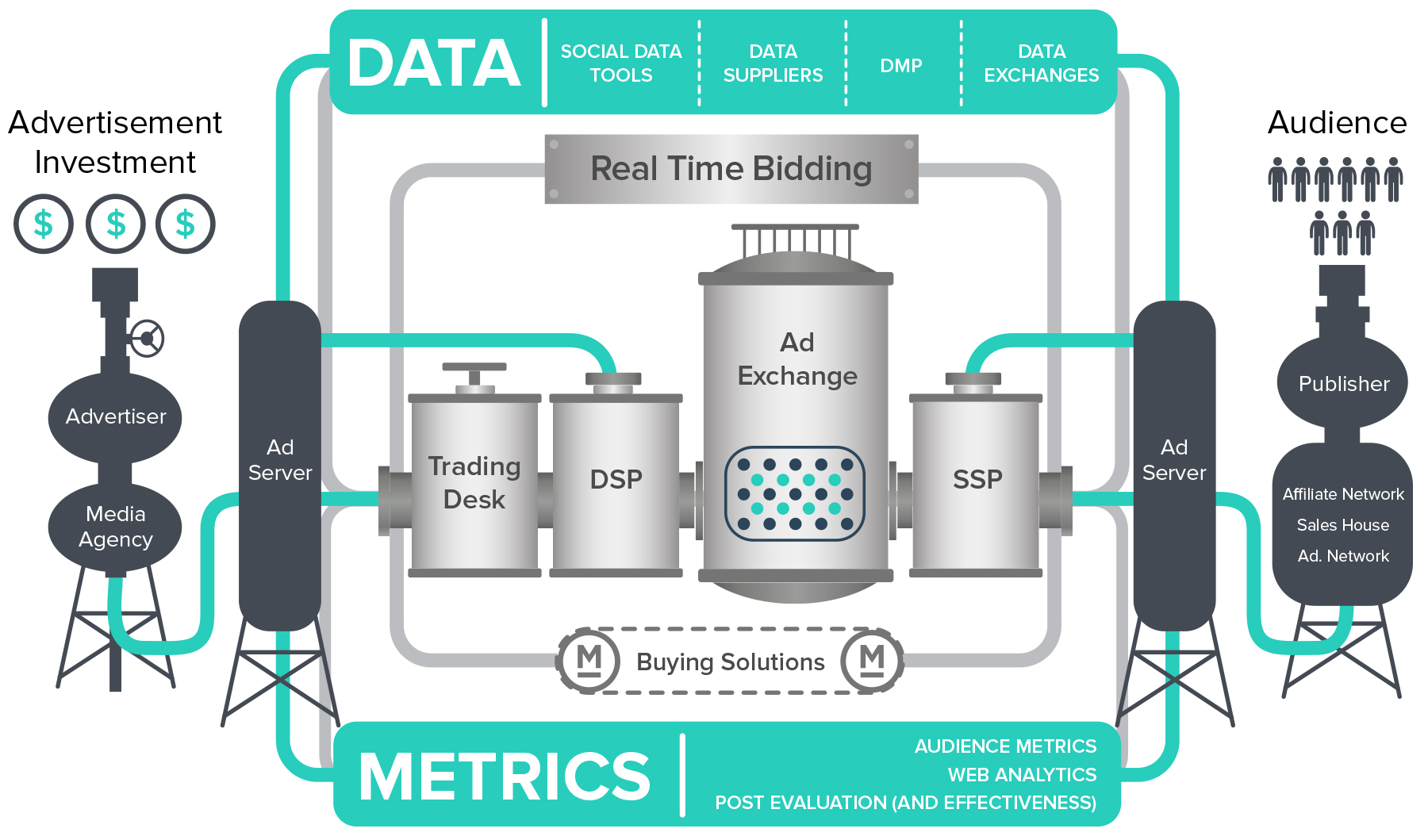
Programmatic Advertising – Just the facts
Programmatic Advertising does the work for you and it works like magic.
Studies from 2018 show that 80% of digital display marketing in the US was done via programmatic advertising and we can only expect that the number will continue to grow. This hypothesis is supported by the incredible and continuous increase of money programmatic advertising has funneled into the digital advertising market. In 2015, programmatic advertising contributed $17.4 billion to the digital advertising market, $25.48 billion in 2016, and projected $45.72 billion in 2019.
Programmatic advertising is high speed and performance, multi-beneficial, and precisely effective. And now that it’s widely accepted, we’re here to break down just how it works and leave you eager to advertise programmatically.
So what exactly is it?
In short, programmatic advertising uses AI and machine learning as a means to automatically buy advertising in real-time, optimizing digital campaigns, instead of harboring over human negotiations and pre-set prices.
Essentially, the overarching goal is to increase efficiency and transparency between the advertiser and the publisher. This is accomplished through a system of real-time auctions that allows advertisers to buy ads at the exact same time as a visitor loads a website – this occurs within milliseconds!
Furthermore, programmatic advertising has range. It exists on a plethora of digital channels such as display, mobile, video, and social. And instead of making itself only available to bigger companies with larger budgets as it onced functions, programmatic advertising is now accessible to smaller brands with self-service tools so that they can finally compete with more established brands without having to overspend expenses on a middleman.
How does it work?
The key component of programmatic advertising is that is utilizes real-time bidding (RTB), which is a method of buying/selling ads through real-time auctions – transactions are made within the 100 ms it takes to load a webpage. It’s that quick…

RTB enhances and fine-tunes an ad campaigns targeting abilities, allowing ads to be served on a case to case basis, meaning that only visitors who fit your target demographic will be shown your ad.
When a visitor enters a website, a request is sent to an ad-exchange along with information about the website and visitor. Will this visitor be a match for your ad?
Next, this information begins to match with available advertisers. This is where the real-time auction/bidding takes place between different advertisers looking for ad space.
Real Life Application:
Susan visits a website that sells sports equipment, but she doesn’t buy anything. Later in the day, she’s clicking through her Instagram stories and out of the blue, she is served a vertical ad for sporting equipment. How random!
On the contrary, this ad placement was not random at all. It was strategically placed in front of Susan within milliseconds thanks to RTB.
Little does Susan know, Dick’s Sporting Goods wanted their ads shown to anybody who had previously been on sporting sites and didn’t make a purchase. So, during the time Susan’s page loaded on her sports equipment site of choice, there was an auction being held for her attention for a company’s ad.
And in this scenario, Dick’s Sporting Goods was the winning bidder and got their ad displayed in front of Susan, in hopes of being the extra push she needed to make a purchase.
However, though RTB is a huge component of programmatic advertising as 90% of programmatic goes through RTB, it is important to note that RTB is not the only tool used. Programmatic also functions through Private Exchange Buying (PMP), an invitation-only marketplace publishers invite certain advertisers to use their space, and Programmatic Direct, a way to purchase a guaranteed amount of impressions on a specific site.
The Beauty of Targeting in Programmatic Advertising
When you want better outcomes for your ads, it’s important to have a target audience to ensure the people viewing your ad actually care about your product or company. There are a few ways to target your ads in a programmatic space.
Contextual Targeting serves ads based on the context of a website that aligns with their product/company. Ex. A women’s shoe brand would most likely want their ad featured in Vogue Magazine, while a investment company would prefer being featured on Forbes’ website.
Keyword Targeting is a form of contextual targeting that targets viewers based on specific keywords. Essentially, you can find sites, articles, web searches, that include your keywords and bid for a space there. Ex. If you sell snowboarding gear, you are most likely going to want to be shown on sites/articles mentioning snow or winter sports, but not simply boarding as that might conflict with skateboarding.
Data Targeting or Audience Targeting is based on a user’s cookies rather than the context of a website. This form of targeting allows an ad to follow you to sites or digital platforms that could have nothing to do with what the company is actually selling. Ex. If you had been searching for home decor before work, and during work found yourself on financial services sites, you could still be served ads selling home decor because the cookies tracked your interests.
Geo-Targeting serves ads based on a customer’s location in relation to the location of the business being advertised. We can also target using language-specific ads. Ex. A children’s daycare center in Orange County would not want to show ads for people living in Los Angeles County or further.
Retargeting is used to bring back viewers to your site if they did not convert the first time into a customer. When a potential customer visits a site, a cookie is placed on their device in order to target them at a later time in hopes of bringing them back to the site to make a purchase. Ex. A young woman visits your make-up site but doesn’t buy your product. So, instead of taking the loss, you continue to place ads for your brand on her socials and other web ventures. At some point she might return to the site and finally purchase.
Not convinced yet? Here are Five Advantages to Programmatic Advertising:
1. Target your KPIs Better
Programmatic technology is perpetually improving its performance on your campaigns KPIs, while increasing overall ROI.
2. Gain More Customer Insights
Programmatic takes away the uncertainty of guessing in ad-buying. Programmatic technology allows you to know and choose the audience that you’re truly looking for, resulting in less dead-end pursuits.
3. Easier Media Buying
With programmatic advertising, we can get rid of the middle man and pe./rson-to-person negotiations. We are able to consolidate our campaigns into one system for all devices and formats in little to no time. Furthermore, we have such easy access to ad inventories, reaching a multitude of exchanges at once without actually doing the hard work of bidding.
4. It’s Cheaper
Programmatic allows advertisers the ability to adjust their own CPMs in real time, which is good for budget and better for targeting.
5. Scalability
You can reach a wider audience through multiple websites quickly, efficiently, and ` precisely.
To discover more about what we can do for your business, get in touch with our team today. Contact us by clicking HERE




![Marketing Under the Influence[r]](https://oculu.com/wp-content/uploads/2022/04/marketing-under-influencer.png)
